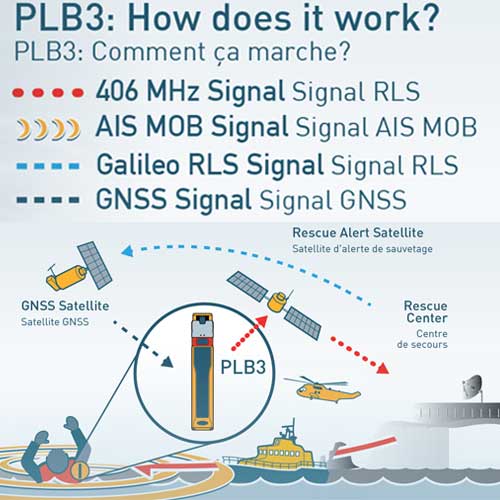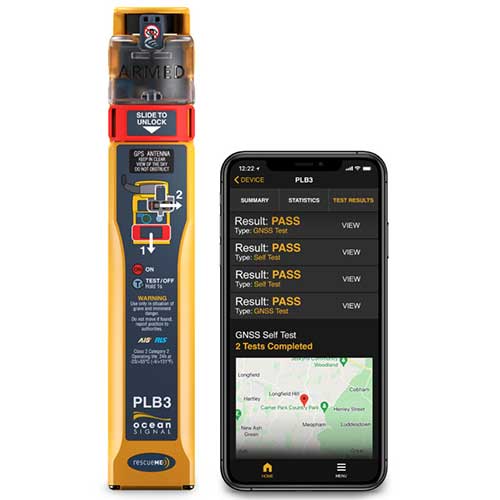- -€74.25
The AIS PLB3 Ocean Signal personal beacon is a locator beacon with AIS, EPIRB, and NFC designed to alert emergency services and emit a signal in the event of personal distress.
This Ocean Signal beacon can be used for all your nautical activities such as fishing, boating, canoeing, kayaking, water skiing, kite-surfing, stand-up paddle, etc...
Read more FeaturesData sheet
- Product type
- Emergency beacon
- Function tag
- Cospas-Sarsat compatible (406Mhz), Radiolocation of rescue vessels (121.50Mhz), AIS technology (162Mhz)
- Battery life
- 5 years
- Geolocation
- GNSS (72 channels), GPS + Glonass (66 channels)
- Trigger
- Manuel
- Category
- Multi-purpose PLB beacon
- MMSI coding
- User registration at https://registre406.cnes.fr (France)
OCEAN SIGNAL - PLB3 PERSONAL LOCATOR BEACON - FOR PRECISE POSITIONING
The PLB3 Ocean Signal is a locator beacon that features Automatic Identification System functionality (AIS), Return Link Service (RLS) technology and Near Field Communication (NFC) capabilities in a 406 MHz personal locator beacon. This enables the optimization of global and local rescue by dramatically improving access to the most effective rescue resources available.
Wherever you are, the Ocean Signal PLB3 personal locator beacon will ensure that rescue services worldwide receive your distress call. In any case, the Ocean Signal PLB3 can be activated with just one hand, locating you even in situations of extreme distress and urgency.
⚠️ Even though this PLB3 beacon is waterproof, it must be above water, pointing skywards with the antenna extended, to work properly. This personal Ocean Signal PLB3 beacon will not function if submerged in water.
 |
INSTALLING THE BEACON ON A LIFEJACKETThe Ocean Signal PLB3 beacon can be installed inside a lifejacket and will activate when the jacket is inflated (semi-automatic). Installation of the beacon is simple, using a small inflation tube clip (supplied) to attach the beacon to the vest with a ribbon connected around the vest's bladder. When the lifejacket is inflated, the beacon antenna deploys, activating the beacon signal at the same time. A second way to install the PLB3 is to attach it directly to the lifejacket. To do this, use the strap clip supplied to attach the beacon to the waistband of the lifejacket or to a strap. For further information, please refer to " LIFEVEST INSTALLATION " in the installation manual at the bottom of the page. ⚠️ Non-floating beacon |
LOCAL & WORLDWIDE RESCUE SYSTEMSThe Ocean Signal PLB3 beacon integrates the global Cospas Sarsat satellite system. It enables your 406 MHz distress signal to reach the international search and rescue network immediately, with GPS position accuracy to within 100m. Integrating several signaling technologies, 406 MHz positioning and GNSS (GPS, Galileo, Glonass), this PLB3 distress beacon also transmits a 121.5 MHz location signal, enabling rescue teams to be guided precisely and in real time to the current location of the PLB3 beacon (whose position may have changed when the distress signal was first sent). Finally, it is equipped with AIS transmissions, which can simultaneously alert all boats (within range) equipped with AIS devices. As soon as the Ocean Signal PLB3 distress beacon is deployed, a AIS message or a MOB alarm (with MMSI identity) is transmitted, and a AIS target is displayed on all AIS screens of nearby vessels. |
 |
 |
RETURN LINK SERVICE (RLS)The PLB3 Ocean Signal personal distress beacon also incorporates return link service (RLS) technology. This means that search and rescue services confirm via the Galileo satellite network that the distress message has been received and the position detected. The man overboard is then informed by a flashing blue light on the PLB3 beacon that his distress signal has been confirmed, taken into account and that help is on its way. This PLB3 Ocean Signal distress beacon also gives rescuers a visual aid by producing a white strobe light, as well as an infrared light for easier location. This is particularly useful when searching at night or in poor visibility. |
NFC CONNECTIVITYThe Sigal PBL3 Ocean beacon also features NFC functionality, enabling it to connect to a smartphone. In addition to the fact that the castaway can see that his distress signal is taken into account by a rescue center, with the EPIRB function he can also access various information from his beacon. Once the Ocean Signal application (available on IOS and Android) has been installed, simply hold your phone up to the beacon and the application will open. It provides a wealth of information :
It also shows the number of self-tests & GNSS tests carried out and passed:
Warning: only works with an NFC (Near Field Communication) compatible smartphone |
 |
PRESENTATION OF THE OCEAN SIGNAL PLB3 PERSONAL BEACON
TECHNICAL SPECIFICATIONS PERSONAL BEACON PLB3 OCEAN SIGNAL
| Satellite Tx | 406 MHz +/- 1 KHz (5W Typ.) |
| AIS Tx | 161.975/162.025 MHz +/- 500 Hz (1W) |
| Tx homing |
121.5MHz, 50mW (nominal) |
| GPS | Multi-constellation receiver (GPS, Galileo, & Glonass GNSS) |
| Activation | Manual or via lifejacket inflation system (semi-automatic) |
| Strobe light | High-intensity LED over 1 candela (flash 20-30/min) |
| Size (H x W x D in cm) | 20 x 3.6 x 3 cm |
| Weight | 190g |
| Battery | Lithium battery, Li/FeS2 |
| Temperature range (storage) | -30°C to +70°C (-22°F to +158°F) |
| Temperature range (operating) | -20°C to +55°C (-4°F to +131°F) |
| Sealing | 10 m (1.0 bar) for 1 hour |
| Floating | No |
| Battery life | 5 years / 24 hours when activated |
| Battery replacement | 6 years after date of manufacture or 5 years after beacon commissioning or emergency use |
| Warranty | 5 years |
KEY FEATURES
|
BOX CONTENTS :
|
🚨For Swiss nationals, please specify when ordering, so that we can set up your beacon correctly.
Customer Reviews (1)
Questions / Answers (5)
Bonjour. Avez-vous un étui étanche en plongée adapté à la balise PLB3 ,? Merci à l'avance Michel MANSAIS
Bonjour Michel, la balise PLB3 est déjà étanche sans besoin d'étui supplémentaire. Elle est étanche à 10m (1.0 bar) pendant 1 heure. En revanche elle ne flotte pas, un étui flottant est disponible. Ref = OS-733S-04213
A savoir : Bien que l'appareil soit étanche, il doit être au-dessus de la surface de l'eau pour fonctionner correctement. Les environnements opérationnels prévus englobent tous les scénarios d'utilisation maritime (sur le pont, à la main, etc.). Dans tous les cas, la PLB doit être orientée vers le ciel avec l'antenne déployée. La PLB ne fonctionnera pas si elle est submergée dans l'eau.
Comment s'effectue l'activation de ma balise ?
Bonjour Olivier, la balise PLB3 peut s'activer de deux manières : automatiquement quand elle est intégrée à un gilet de sauvetage (la balise s'active lors du gonflage du gilet) ou manuellement en cas d'urgence (faite glisser le curseur rouge d'armement vers le bas puis le curseur gris d'activation vers la gauche ou la droite).
Bonjour, je voulais savoir si ma batterie fonctionnait bien ?
Bonjour Raoul, pour vérifier le bon fonctionnement de la balise, vous pouvez effectuer un test régulier avec la fonction intégrée de test d'autodiagnostic. Pour cela, respectez ces différentes étapes :
-
Appuyez brièvement sur le bouton TEST (généralement marqué "TEST/OFF").
-
La balise effectuera un autocontrôle complet :
-
Vérification du GPS
-
Vérification de l’antenne
-
Vérification des voyants lumineux
-
Vérification de la batterie
-
-
Observez les voyants :
-
LED verte clignotante = test réussi, balise opérationnelle
-
LED rouge clignotante = test échoué, anomalie détectée (consultez le manuel)
-
Attention : ne maintenez pas le bouton trop longtemps, sinon vous pourriez déclencher une émission réelle de détresse.
Est-ce que je dois enregistrer ma balise, si oui comment faire ?
Bonjour Cyril, oui, il est absolument nécessaire d’enregistrer la balise avant de l’utiliser. C’est une obligation légale et une étape essentielle pour que les services de secours puissent intervenir efficacement en cas de détresse. Pour cela, il faut vous enregistrer sur le site de l'ANFR. Vous devrez alors fournir :
- Le numéro HEX ID (ou UIN) gravé sur la balise
- Vos coordonnées personnelles
- Les détails de votre bateau ou activité
- Des contacts d'urgence
Quelle est la précision de la localisation de la balise ?
Bonjour John, la précision de la localisation de la PLB3 est de l'ordre de ± 10 mètres dans ces conditions de mer normales.

